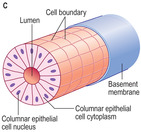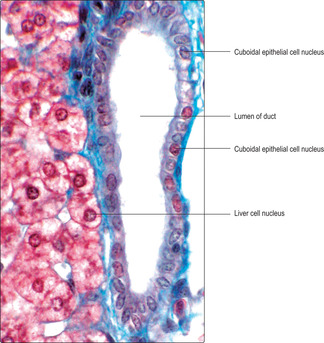epithelial tissue
Introduction to primary issues
This classification is still in wide use and is the basis for all studies aimed at understanding the structure and function of normal and abnormal cells, tissues and organs of the body.
Epithelial tissues in general lie on surfaces (epi = on or upon) and many carry out secretory and other highly specialised functions. Cells from some epithelia migrate from surfaces during development in utero and form glands within the body (e.g. the pancreas) and produce and secrete various molecules. The names of the other primary tissues (connective, muscle and nerve) indicate the prime functions of the components of these tissues in their titles, respectively the connection of structures, contraction of muscles and conduction of nerve impulses.
Epithelial tissue
Epithelial tissue consists mainly of epithelial cells which form layers (epithelia) covering the body and structures in the body such as organs. Epithelial tissues also form the linings of hollow structures in the body and form the outer layer(s) of some membranes. Epithelial cells are the major cell type forming the parenchyma of some solid organs and glands and are involved in synthesising and secreting many substances. In addition to secretion, epithelia are involved in a variety of functions, including transport of substances, absorption of molecules, modulation of permeability and protection, and in detecting some sensations. Although epithelia exhibit a variety of forms and functions they all consist of epithelial cells which are tightly bound to each other by specialised junctions (Chapter 2). The importance of epithelia to body function is apparent when it is realised that every molecule or organism that enters (or leaves) the body has to pass through an epithelium.
Epithelia lining and covering structures
Epithelia are categorised as:
■ simple epithelia, which consist of a single layer of epithelial cells
■ compound (stratified) epithelia, which display several layers of cells.
In each of these categories there are sub-categories, classified according to the shape of the epithelial cells.
Simple epithelia
In simple epithelia, each epithelial cell is attached to a basement membrane (sometimes called a basal lamina). The basement membrane is a concentration of extracellular material, including glycoproteins and connective tissue fibres (mainly collagen) (Chapter 4).
Simple epithelia comprise four main types:
Simple squamous epithelia
Squamous epithelial cells are irregularly shaped, flattened (pavement like) and fit intimately together. The nuclei in squamous cells often occupy a central position, and, given that the cytoplasm of the cells is generally flattened, a bulge may be apparent in the region of the nucleus (Fig. 3.1A). An important function of simple, squamous epithelial cells is that they facilitate the transport of gases and/or other substances across the epithelium. Examples of the location of squamous epithelia include the linings of blood vessels (Fig. 3.2), which are known as endothelia, and the walls of lung alveoli, i.e. regions where the move-ment of oxygen and carbon dioxide is important.
Simple cuboidal epithelia
Epithelial cells in cuboidal epithelia are shaped like boxes, with fairly square profiles, and each cell has a roughly centrally placed nucleus. Unlike squamous cells, their nuclei do not bulge as there is ample cytoplasm around them (Fig. 3.1B). Examples of where this cell type may be found include the lining of the walls of ducts in the liver (Fig. 3.3) and the walls of ducts draining glands, e.g. sweat glands. Their function varies with their location and may involve synthesis and secretion, or excretion, or absorption of molecules.
Simple columnar epithelia
Columnar epithelial cells have the shape of columns with their longest dimension at right angles to the basement membrane. Their nuclei typically lie near the basement membrane (Fig. 3.1C) or about half-way along their length. Columnar epithelial cells are present in the lining of the wall of the gastrointestinal tract (Fig. 3.4), the gall bladder and some tubules in the kidney, for example. In many locations, they are associated with the function of absorption of substances into the cells across their apical (luminal) surface and then out of the cells via the basal surface and then across their basement membrane. The apical surfaces of many absorptive columnar epithelial cells display a ‘brush border’ appearance (Fig. 3.4) when examined by light microscopy and this is due to the presence of microvilli (Chapter 2). The microvilli increase the surface area of the luminal membrane of absorptive cells and thus increase the efficiency of the transport of molecules.
Pseudostratified columnar epithelia
This type of epithelium is called ‘pseudostratified’ because it appears as though it is composed of several layers but each cell actually has an attachment to the basement membrane (Fig. 3.1D
Buy Membership for Basic Science Category to continue reading. Learn more here










